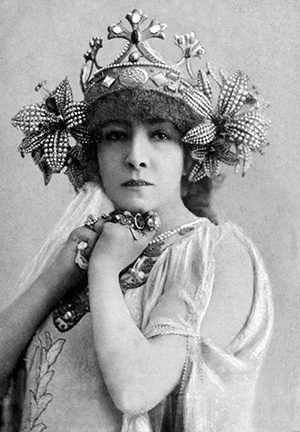|
Legacy
The Power of the Courtesan
The demimonde actresses of Belle Époque Paris helped bring Art Nouveau jewelry to the attention of society’s elite.
By Phyllis Schiller

|
| French actress Sarah Bernhardt (1844-1923) in costume for the play La Princesse Lointaine by Edmond Rostand, photographed circa 1911. Photo by Apic/Getty Images. |
Now in its third year, the Jewelry History Series at The Original Miami Beach Antique Show offers retailers, wholesalers and jewelry aficionados attending the show an entertaining “jewelry education,” explains Elyse Zorn Karlin, co-director of the Association for the Study of Jewelry and Related Arts, co-director of the series with Gail Brett Levine, executive director of the National Association of Jewelry Appraisers. Held two days prior to the opening of the show, the series’ aim, says Karlin, is to offer a range of diverse topics that attendees might not be familiar with, covered by experts in the field. Certainly, that could be said of the topic Karlin is speaking on at this year’s session, “Jewelry of the French Courtesans.”
Although the love affair between courtesans and beautiful jewelry can be traced throughout French history, Karlin says she became interested in the topic in her study of the Art Nouveau period. When the Belle Époque courtesans, many of whom were actresses, wore this jewelry on and off stage, they brought the Art Nouveau style to the attention of the Paris elite.
These courtesans, or “Les Grandes Horizontales” as they were also known, in many ways filled the role of today’s red-carpet celebrities, notes Karlin. “Many of them appeared on the stage — the most famous being Sarah Bernhardt. What they wore was in the forefront of the public eye.” It was accepted that rich men would support them and shower them with jewels and other finery.
“It wasn’t just about sex,” continues Karlin. “These women could talk about art and politics. The famous men and royalty they were involved with wanted companions who also could keep them occupied mentally. Art Nouveau ended around WWI and the world of the courtesan ended about the same time, when, in the aftermath of the war, everything changed.”
The fabulous jewels the courtesans were given was their retirement plan, although most of them lost it all by the time they died, says Karlin. The more extensive their jewelry collection, the more their reputation grew. Two famous courtesans, Liane de Pougy and La Belle Otero, both with the Folies Bergère, were jewelry rivals. They would go out to nightclubs flaunting their finery, trying to best one another with the quality and quantity of their jewels. The story goes, says Karlin, “one evening, de Pougy went to the nightclub, but instead of wearing her jewels, she had her maid walk behind her carrying a cushion topped by a chest overflowing with every jewel de Pougy owned.” Nearly every precious gemstone was part of the courtesan’s jewelry collection, along with “important” pearls, says Karlin.
The courtesans/actresses were the celebrities of the time, reported on in magazines and shown on posters and postcards and other kinds of advertising. What these women wore was noticed, and copied, says Karlin. “A lot of their costumes were covered in jewels. La Belle Otero had a vest made of diamonds and pearls worth a fortune. When she wasn’t wearing it on stage, she had armed guards taking care of it.” Cora Pearl was another notable courtesan. “Although not much of an actress,” Karlin says, “when she finally got an opportunity to get on stage, her costume seemed to consist solely of strategically placed diamonds. The soles of her boots were also covered in diamonds.”
Bernhardt amassed a significant jewelry collection, both gifts from her lovers and pieces she bought herself. She had a keen eye for spotting talent, notes Karlin, and had pieces created by some of Art Nouveau’s leading designers. “She became aware of René Lalique when he was first starting out,” says Karlin. “And he designed jewelry for her, both for the stage and for her private use. It was audacious, larger-than-life jewelry of the type not seen before. But by wearing his jewelry in public, Bernhardt helped popularize him. Otherwise, I’m not sure he would have become as famous.” And by also designing her stage jewelry, Karlin goes on to say, “Lalique was able to create fantastic pieces he might not have done otherwise.” One example Karlin cites is a headdress Bernhardt wore for the play Theodora, “a big crown that has snakes, griffins and shoulder-length strings of beads that hung down to her shoulders.” Bernhardt was also a patron of Alphonse Mucha, “who was a nobody when she chose him to design her posters. He did a lot of her jewelry and costumes. He also became famous because of her. She had that kind of power.”
It’s a power that continues into present day. A snake-shaped gold and enamel bracelet with diamonds and opals, designed by Mucha and created by Georges Fouquet for Bernhardt in 1899, sold at Christie’s Geneva in 1987 for $757,246, setting a then record for the highest price paid for a piece of Art Nouveau jewelry sold at auction. A beautiful necklace by Lalique, “with a big, gold pendant adorned with European-cut diamonds, depicted Bernhardt as Mélissande in the play La Princesse Lointaine, written by Edmond Rostand.” It was sold at Christie’s New York in 2009, along with a leather-bound copy of the play set with gemstones, a gift to Bernhardt from Rostand, and garnered $554,500.
“The Belle Époque courtesans were definitely trendsetters,” sums up Karlin. “They were another strata of society to whom wealthy women looked for their fashion cues. They definitely influenced the acceptance of Art Nouveau jewelry.”
The Jewelry History Series will be held January 26-27, 2016, at The Miami Beach Convention Center. For price and registration information, go to www.originalmiamibeachantiqueshow.com/show/jewelry-series/.Article from the Rapaport Magazine - December 2015. To subscribe click here.
|
|